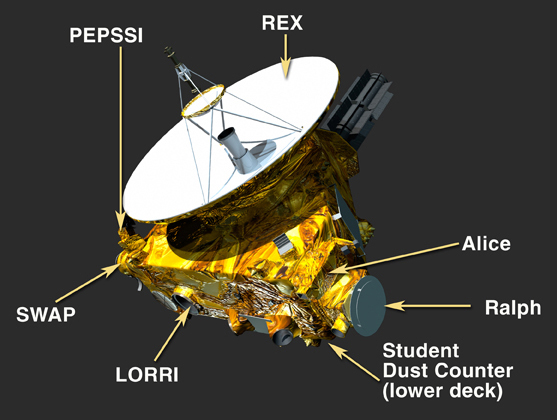
The New Horizons science payload consists of seven instruments — three optical instruments, two plasma instruments, a dust sensor and a radio science receiver/radiometer. This payload was designed to investigate the global geology, surface composition and temperature, and the atmospheric pressure, temperature and escape rate of Pluto and its moons.
The same payload was used to explore Arrokoth, the most distant object ever targeted for a flyby.
The payload is incredibly power efficient — with the instruments collectively drawing less than 28 watts — and represents a degree of miniaturization that is unprecedented in planetary exploration. The instruments were designed specifically to handle the cold conditions and low light levels in the Kuiper Belt.
Alice
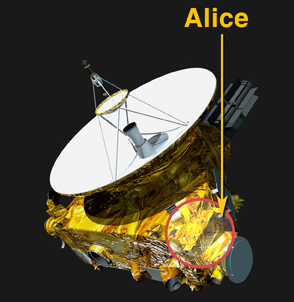
Mass: 4.5 kilograms (9.9 pounds)
Average Power: 4.4 watts
Development: Southwest Research Institute
Principal Investigator: Alan Stern, Southwest Research Institute
Purpose: Study atmospheric composition and structure
Alice is a sensitive ultraviolet imaging spectrometer designed to probe the composition and structure of Pluto's dynamic atmosphere. Where a spectrometer separates light into its constituent wavelengths (like a prism), an "imaging spectrometer" both separates the different wavelengths of light and produces an image of the target at each wavelength. Alice's spectroscopic range extends across both extreme and far-ultraviolet wavelengths from approximately 500 to 1,800 Angstroms. The instrument detected a variety of important chemicals in Pluto's atmosphere, and determined their relative abundances, giving scientists the first complete picture of Pluto's atmospheric composition. Alice set tight upper limits on the maximum density of any ionosphere around Pluto and on that of any atmosphere around Pluto's largest moon, Charon. It also searched for (but didn't find) an atmosphere or exosphere around Arrokoth.
Alice consists of a compact telescope, a spectrograph, and a sensitive electronic detector with 1,024 spectral channels at each of 32 separate spatial locations in its long, rectangular field of view. Alice has two modes of operation: an "airglow" mode that measures ultraviolet emissions from atmospheric constituents, and an "occultation" mode, where it views the Sun or a bright star through an atmosphere and detects atmospheric constituents by the amount of sunlight they absorb. Absorption of sunlight by the atmosphere at Pluto showed up as characteristic "dips" and "edges" in the ultraviolet part of the spectrum of light that Alice measured. This technique is a powerful method for measured even traces of atmospheric gas.
A first-generation version of New Horizons' Alice (smaller and a bit less sophisticated) flew aboard the European Space Agency's Rosetta spacecraft, used to explore the escaping atmosphere and complex surface of a comet. Later versions are flying or scheduled to fly aboard LRO, JUNO, JUICE and Europa Clipper.
Ralph
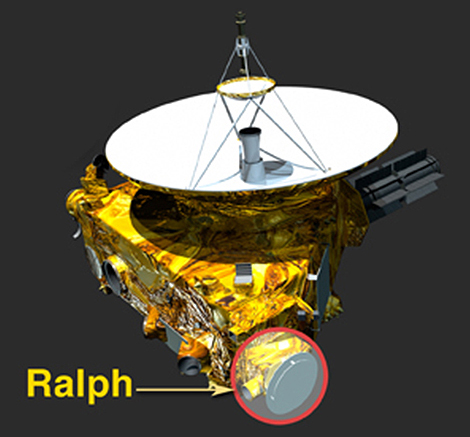
Mass: 10.3 kilograms (22.7 pounds)
Average Power: 6.3 watts
Development: Ball Aerospace Corporation, NASA Goddard Space Flight Center, Southwest Research Institute
Principal Investigator: Cathy Olkin, Southwest Research Institute
Purpose: Study surface geology and morphology; obtain surface composition and surface temperature maps
Ralph is the main "eyes" of New Horizons and is charged with making the maps that show what Pluto, its moons, and other Kuiper Belt Objects look like. (The instrument is so named because it's coupled with the Alice ultraviolet spectrometer in the New Horizons remote-sensing package — a reference familiar to fans of "The Honeymooners" TV show.)
Ralph consists of three panchromatic (black-and-white) and four color imagers inside its Multispectral Visible Imaging Camera (MVIC), as well as an infrared compositional mapping spectrometer called the Linear Etalon Imaging Spectral Array (LEISA). LEISA is an advanced, miniaturized short-wavelength infrared (1.25-2.50 micron) spectrometer provided by scientists from NASA's Goddard Space Flight Center. MVIC operates over the bandpass from 0.4 to 0.95 microns. Ralph's suite of eight detectors — seven charge-coupled devices (CCDs) like those found in a digital camera, and a single infrared array detector — are fed by a single, sensitive magnifying telescope with a resolution more than 10 times better than the human eye can see. The entire package operates on less than half the wattage of an appliance light bulb.
Ralph took images at increasing frequency as New Horizons approached, flew past, and then looked back at the Pluto system. The MVIC images helped scientists to map landforms in black-and-white and color with a best resolution of about 250 meters (820 feet) per pixel, create stereo images to determine surface topography, and refine the radii and orbits of Pluto and its moons. With the LORRI instrument, it found clouds and hazes in Pluto's atmosphere, and searched for rings and additional satellites around Pluto. It also obtained images of Pluto's night side, illuminated by "Charon-light." At the same time, LEISA mapped the amounts of nitrogen, methane, carbon monoxide, and frozen water and other materials, including organic compounds, across the sunlit surfaces of Pluto and its moons.
It also let scientists map surface temperatures across Pluto and Charon by sensing the spectral features of frozen nitrogen, water and carbon monoxide.
Radio Science Experiment (REX)
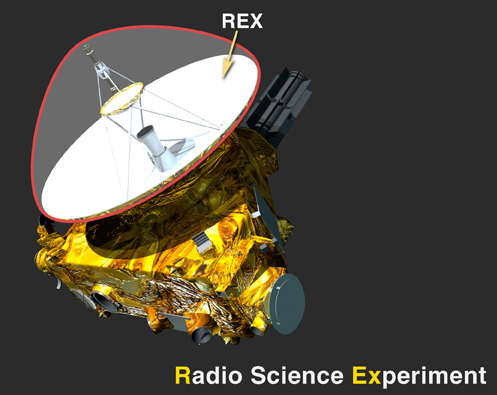
Mass: 100 grams (3.5 ounces)
Average Power: 2.1 watts
Development: Johns Hopkins University Applied Physics Laboratory, Stanford University
Principal Investigators: Len Tyler and Ivan Linscott, Stanford University
Purpose: Measure atmospheric temperature and pressure (down to the surface); measure density of the ionosphere; search for atmospheres around Charon and other KBOs
REX consists only of a small printed circuit board containing sophisticated signal-processing electronics integrated into the New Horizons telecommunications system. Because the telecom system is redundant within New Horizons, the spacecraft carries two copies of REX. Both can be used simultaneously to improve the data return from the radio science experiment.
REX used an occultation technique to probe Pluto's atmosphere and to search for an atmosphere around Charon. After New Horizons flew by Pluto, its 2.1-meter (83-inch) dish antenna pointed back at Earth. On Earth, powerful transmitters in NASA's largest Deep Space Network antennas beamed radio signals to the spacecraft as it passed behind Pluto. The radio waves bent according to the average molecular weight of gas in the atmosphere and the atmospheric temperature.
Space missions typically conduct this type of experiment by sending a signal from the spacecraft through a planet's atmosphere and back to Earth. (This is called a "downlink" radio experiment.) New Horizons was the first to use a signal from Earth — the spacecraft was so far from home and moving so quickly past Pluto and Charon that only a large, ground-based antenna could provide a strong enough signal. This new technique, called an "uplink" radio experiment, is an important advance beyond previous outer planet missions.
Scientists use REX data to derive accurate globally averaged day-side and night-side temperature measurements. Also, by using REX to track slight changes in the spacecraft's path, scientists measured the masses of Pluto and Charon. By timing the length of the radio occultations of Pluto and Charon, REX also yielded improved radii measurements for each body.
Long Range Reconnaissance Imager (LORRI)
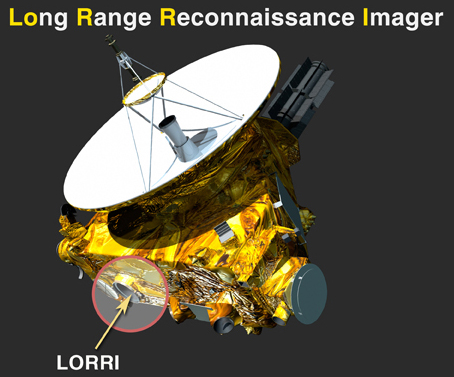
Mass: 8.8 kilograms (19.4 pounds)
Average Power: 5.8 watts
Development: Johns Hopkins University Applied Physics Laboratory
Principal Investigator: Hal Weaver, Applied Physics Laboratory
Purpose: Study geology; provide high-resolution approach and highest-resolution encounter images
LORRI, the "eagle eyes" of New Horizons, is a panchromatic high-magnification imager, consisting of a telescope with an 8.2-inch (20.8-centimeter) aperture that focuses visible light onto a charge-coupled device (CCD). It's essentially a digital camera with a large telephoto telescope — only fortified to operate in the cold, hostile environs near Pluto and beyond.
During the encounter, LORRI images were New Horizons' first of the Pluto system, starting about 180 days before closest approach. Pluto and its moons still resembled little more than bright dots, but these system-wide views helped navigators keep the spacecraft on course and helped scientists refine their orbit calculations of Pluto and its moons. Approximately 60 days before closest approach — around mid-May 2015 — LORRI images began to surpass Hubble-quality resolution, providing never-before-seen details each day. At closest approach, LORRI imaged select sections of Pluto's sunlit surface at football-field-size resolution, resolving features at about 50 meters across.
This range of images gave scientists an unprecedented look at the geology on Pluto and its moons— including the number and size of craters on each surface, revealing the history of impacting objects in that distant region. LORRI also yielded important information on the history of Pluto's surface, searched for activity such as geysers on that surface, and looked for hazes in Pluto's atmosphere. LORRI is also providing the highest resolution and sensitivity images of many Kuiper Belt Objects as New Horizons passes them in the extended mission.
LORRI has no color filters or moving parts — operators take images by pointing the LORRI side of the spacecraft directly at their target. The instrument's innovative silicon carbide construction keeps its mirrors focused through the extreme temperature dips New Horizons has experienced on the way to and through the Kuiper Belt.
Solar Wind Around Pluto (SWAP)
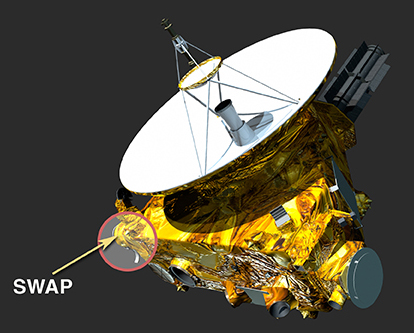
Mass: 3.3 kilograms (7.3 pounds)
Average Power: 2.3 watts
Development: Southwest Research Institute
Principal Investigator: David McComas, Princeton University
Purpose: Study solar wind interactions and atmospheric escape
The SWAP instrument will measure interactions of Pluto with the solar wind — the stream of fast charged particles flowing from the Sun. The incredible distance of Pluto from the Sun required the SWAP team to build the largest-aperture instrument ever used to measure the solar wind.
The atmospheric gases that escape Pluto's weak gravity leave the planet as neutral atoms and molecules. These atoms and molecules are ionized by ultraviolet sunlight (similar to Earth's upper atmosphere and ionosphere). Once they become electrically charged, the ions and electrons are "picked up" and carried away by the solar wind. In the process, these pickup ions gain substantial energy (thousands of electron-volts). This energy comes from the solar wind, which is correspondingly slowed down and diverted around Pluto. SWAP measures low-energy interactions, such as those caused by the solar wind. By measuring how the solar wind is perturbed by the interaction with Pluto's escaping atmosphere, SWAP helped to determine the escape rate of atmospheric material from Pluto.
At the top of its energy range SWAP can detect some pickup ions (up to 6.5 kiloelectron volts, or keV). SWAP combines a retarding potential analyzer (RPA) with an electrostatic analyzer (ESA) to enable extremely fine, accurate energy measurements of the solar wind, allowing New Horizons to measure minute changes in solar wind speed. The amount of Pluto's atmosphere that escapes into space provides critical insights into the structure and destiny of the atmosphere itself.
Pluto Energetic Particle Spectrometer Science Investigation (PEPSSI)
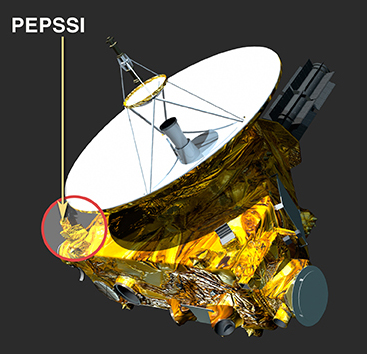
Mass: 1.5 kilograms (3.3 pounds)
Average Power: 2.5 watts
Development: Johns Hopkins University Applied Physics Laboratory
Principal Investigator: Ralph McNutt Jr., Applied Physics Laboratory
Purpose: Study the density, composition, and nature of energetic particles and plasmas resulting from the escape of Pluto's atmosphere
PEPSSI, the most compact, lowest-power directional energetic particle spectrometer flown on a space mission, searched for neutral atoms that escape Pluto's atmosphere and become charged by their interaction with the solar wind. It detected the material that escapes from Pluto's atmosphere (such as molecular nitrogen, carbon monoxide and methane), which breaks up into ions and electrons after absorbing the Sun's ultraviolet light, and streams away from Pluto as "pickup" ions carried by the solar wind.
By using PEPSSI data to count particles, and knowing how far New Horizons was from Pluto at a given time, scientists will be able to tell how quickly the planet's atmosphere is escaping and gain new information about what the atmosphere is made of.
PEPSSI is a classic "time-of-flight" particle instrument: particles enter the detector and knock other particles (electrons) from a thin foil; they zip toward another foil before hitting a solid-state detector. The instrument clocks the time between the foil collisions to tell the particle's speed (measuring its mass) and figures its total energy when it collides with the solid-state detector. From this, scientists can determine the composition of each particle. PEPSSI can measure energetic particles up to 1,000 kiloelectron volts (keV), many times more energetic than what SWAP can measure. Together the two instruments made a powerful combination for studying the Pluto system.
Venetia Burney Student Dust Counter (SDC)
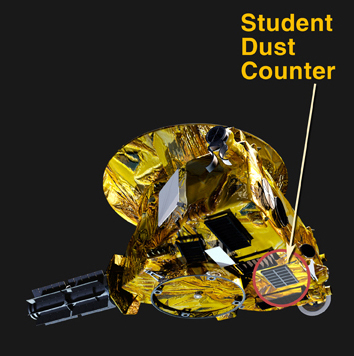
Mass: 1.9 kilograms (4.2 pounds)
Average Power: 5 watts
Development: Laboratory for Atmospheric and Space Physics, University of Colorado at Boulder
Principal Investigator: Mihaly Horanyi, University of Colorado at Boulder
Purpose: Measure concentration of dust particles in outer solar system
Designed and built by students at the University of Colorado at Boulder, the SDC detects microscopic dust grains produced by collisions among asteroids, comets, and even Kuiper Belt Objects during New Horizons' long journey. Officially a New Horizons Education and Public Outreach project, SDC is the first science instrument on a NASA planetary mission to be designed, built and "flown" by students. The SDC counts and measures the sizes of dust particles, producing information on the collision rates of such bodies in the outer solar system. At Pluto, SDC was also used to search for dust that might be generated by collisions of tiny "impactors" on Pluto's small moons.
The instrument includes two major pieces: an 18-by-12-inch detector assembly, which is mounted on the outside of the spacecraft and exposed to the dust particles; and an electronics box inside the spacecraft that, when a hit occurs on the detector, deciphers the data and determines the mass and speed of the particle. Because no dust detector has ever operated beyond 18 astronomical units from the Sun (nearly 1.7 billion miles, about the distance from Uranus to the Sun), SDC data is giving scientists an unprecedented look at the sources and transport of dust in the solar system.
With faculty support, University of Colorado students have been distributing and archiving data from the instrument, and lead a comprehensive education and outreach effort to bring their results and experiences to classrooms of all grades.
In June 2006 the instrument was named for Venetia Burney, who at age 11 offered the name "Pluto" for the newly discovered ninth planet in 1930.
Tech Specs
View a chart of instrument technical specifications »
Payload Technical Specifications
The New Horizons Science Instrument Suite
| Instrument Name |
PI |
Wavelength / Energy / Mass Range |
Field of View (milliradians) |
Angular Resolution (milliradians / pixel) |
Wavelength / Energy / Mass Resolution per pixel |
| Alice: ultraviolet mapping spectrometer |
Alan Stern, SwRI |
52 - 180 nm |
1.7x 70 (slit). 35 x 35 (solar occultation aperture) |
1.7 x 5.2 |
0.183 nm |
| LORRI: Long-Range Reconnaisance Imager |
Andy Cheng, APL |
350 - 850nm |
5.08 x 5.08 |
0.00496 |
N/A |
| Ralph MVIC: Multispectral Visible Imaging Camera |
Alan Stern, SwRI |
450 - 1000nm (Pan);
425 - 550nm (Blue);
540 - 700nm (Red); 780 - 1000nm (IR);
860 - 910 nm (CH4) |
Multicolor: 100 x N (pushbroom). OpNav, pan only: 100 x 2.6 (framing)
|
0.02 |
See filter bandpasses |
| Ralph LEISA (Linear Etalon Imaging Spectral Array): infrared spectrometer |
Alan Stern, SwRI |
1250 - 2500 nm |
15.9 x 15.9 |
0.062 |
Full spectral range: R=300
(~6.5 nm / pixel).
2100 - 2250 nm: R=600
(~3.7 nm / pixel). |
| REX: Radio science EXperiment |
Len Tyler, Stanford University |
4.1 cm. |
20 |
20 |
Radiometry mode: N/A. Occultation mode: 3 x 10-13
in
Δ
f/f
|
| SDC: Student Dust Counter |
Mihaly Horanyi, U. Colorado |
4x10-12 - 4x10-9 g |
~p
|
N/A |
~ factor of 2 in mass |
| PEPSSI (Pluto Energetic Particle Spectrometer Science Investigation): medium energy particle spectrometer |
Ralph McNutt, APL |
25 - 1000 keV (protons); 60-1000 keV (atomic ions) ;
25 - 500 keV (electrons) |
160 deg x 12 deg |
25 x 12 deg |
0.25 keV |
| SWAP (Solar Wind Around Pluto): low energy plasma instrument |
Dave McComas, SwRI |
30 eV - 7.7 keV |
270 deg x 10 deg (deflection angles up to +15 deg additional) |
N/A |
1 eV (<2 keV)
9% (>2 keV) |







